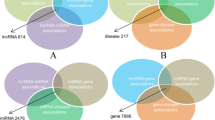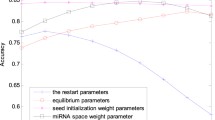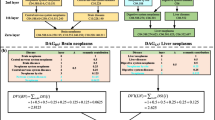Abstract
MicroRNA refers to a set of small non-coding RNA which plays important roles in regulating specific mRNA targets and suppressing their expression. Previous researches have verified that the deregulations of microRNA are closely associated with human disease. However it is still a big challenge to design an effective computational method which can integrate multiple biological information to predict microRNA-disease associations. Based on the observation that microRNAs with similar functions tend to associate with common diseases, the diseases sharing similar phenotypes are likely caused by common microRNAs and similar environment factors also affect microRNAs with similar functions and diseases with similar phenotypes. In this work, we design a computational method which can combine microRNA, disease and environmental factors to predict microRNA-disease associations. The method namely ThrRWMDE, takes several steps of random walking on three different biological networks, microRNA-microRNA functional similarity network(MFN), disease-disease similarity network(DSN) and environmental factor similarity network(ESN) respectively so as to get microRNA-disease association information from the neighbors in corresponding networks. In the course of walking, the microRNA-disease association information will also be transferred from one network to another according to the interactions between the nodes in different networks. Our method is not only a framework which can effectively integrate different types of biological methods but also can easily treat these information differently with respect to the topological and structural difference of the three networks. The results of experiment show that our method achieves better prediction performance than other state-of-the-art methods.
Access this chapter
Tax calculation will be finalised at checkout
Purchases are for personal use only
Similar content being viewed by others
References
Jiang, Q., Hao, Y., Wang, G., Juan, L., Zhang, T., Teng, M., Liu, Y., Wang, Y.: Prioritization of disease micrornas through a human phenome-micrornaome network. BMC Syst. Biol. 4(Suppl. 1), S2 (2010)
Xuan, P., Han, K., Guo, M., Guo, Y., Li, J., Ding, J., Liu, Y., Dai, Q., Li, J., Teng, Z., et al.: Prediction of micrornas associated with human diseases based on weighted k most similar neighbors. PloS One 8(8), e70204 (2013)
Chen, X., Liu, M.X., Yan, G.Y.: RWRMDA: predicting novel human microrna-disease associations. Mol. BioSyst. 8(10), 2792–2798 (2012)
Chen, X., Yan, G.Y.: Semi-supervised learning for potential human microrna-disease associations inference. Sci. Rep. 4, Article No.5501 (2014)
Jiang, Q., Wang, G., Wang, Y.: An approach for prioritizing disease-related micrornas based on genomic data integration. In: 2010 3rd International Conference on Biomedical Engineering and Informatics (BMEI), vol. 6, pp. 2270–2274. IEEE (2010)
Shi, H., Xu, J., Zhang, G., Xu, L., Li, C., Wang, L., Zhao, Z., Jiang, W., Guo, Z., Li, X.: Walking the interactome to identify human miRNA-disease associations through the functional link between miRNA targets and disease genes. BMC Syst. Biol. 7(1), 101 (2013)
Chen, H., Zhang, Z.: Similarity-based methods for potential human microRNA-disease association prediction. BMC Med. Genom. 6(1), 12 (2013)
Lan, W., Wang, J., Li, M., Liu, J., Pan, Y.: Predicting microRNA-disease associations by integrating multiple biological information. In: 2015 IEEE International Conference on Bioinformatics and Biomedicine (BIBM), pp. 183–188. IEEE (2015)
Zeng, X., Zhang, X., Zou, Q.: Integrative approaches for predicting microRNA function and prioritizing disease-related microRNA using biological interaction networks. Brief. Bioinform. 17, 193–203 (2015)
Das, U.N.: Obesity: genes, brain, gut, and environment. Nutrition 26(5), 459–473 (2010)
Yang, Q., Qiu, C., Yang, J., Wu, Q., Cui, Q.: miREnvironment database: providing a bridge for microRNAs, environmental factors and phenotypes. Bioinformatics 27(23), 3329–3330 (2011)
Qiu, C., Chen, G., Cui, Q.: Towards the understanding of microRNA and environmental factor interactions and their relationships to human diseases. Sci. Rep. 2, Article No.318 (2012)
Chen, X., Liu, M.X., Cui, Q.H., Yan, G.Y.: Prediction of disease-related interactions between microRNAs and environmental factors based on a semi-supervised classifier. PloS One 7(8), e43425 (2012)
Li, J., Wu, Z., Cheng, F., Li, W., Liu, G., Tang, Y.: Computational prediction of microRNA networks incorporating environmental toxicity and disease etiology. Sci. Rep. 4, Article No.5576 (2014)
Wang, D., Wang, J., Lu, M., Song, F., Cui, Q.: Inferring the human microRNA functional similarity and functional network based on microRNA-associated diseases. Bioinformatics 26(13), 1644–1650 (2010)
Li, Y., Qiu, C., Tu, J., Geng, B., Yang, J., Jiang, T., Cui, Q.: Hmdd v2. 0: a database for experimentally supported human microRNA and disease associations. Nucleic Acids Res. gkt1023, 1–5 (2013)
Cheng, L., Li, J., Ju, P., Peng, J., Wang, Y.: SemFunSim: a new method for measuring disease similarity by integrating semantic and gene functional association. PloS One 9(6), e99415 (2014)
Hattori, M., Okuno, Y., Goto, S., Kanehisa, M.: Development of a chemical structure comparison method for integrated analysis of chemical and genomic information in the metabolic pathways. J. Am. Chem. Soc. 125(39), 11853–11865 (2003)
Acknowledgement
This work is supported in part by the National Natural Science Foundation of China under grant no. 61502214, 31560317, 61472133, 61502166, 81460007 and 81560221.
Author information
Authors and Affiliations
Corresponding author
Editor information
Editors and Affiliations
Rights and permissions
Copyright information
© 2016 Springer International Publishing Switzerland
About this paper
Cite this paper
Peng, W., Lan, W., Yu, Z., Wang, J., Pan, Y. (2016). Predicting MicroRNA-Disease Associations by Random Walking on Multiple Networks. In: Bourgeois, A., Skums, P., Wan, X., Zelikovsky, A. (eds) Bioinformatics Research and Applications. ISBRA 2016. Lecture Notes in Computer Science(), vol 9683. Springer, Cham. https://doi.org/10.1007/978-3-319-38782-6_11
Download citation
DOI: https://doi.org/10.1007/978-3-319-38782-6_11
Published:
Publisher Name: Springer, Cham
Print ISBN: 978-3-319-38781-9
Online ISBN: 978-3-319-38782-6
eBook Packages: Computer ScienceComputer Science (R0)




